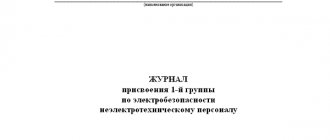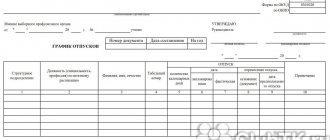Property damage report is a document that records damage caused to inventory items belonging to the enterprise. In this case, the intentionality or unintentionality of the actions that caused the damage to the property does not play a role - the act is drawn up regardless of these circumstances.
- Form and sample
- Free download
- Online viewing
- Expert tested
FILES
Examples of property damage acts:
- when an apartment or office is flooded - when performing any work - when delivering or transporting goods - namely documents
Why is the act needed?
The report refers to the primary documentation of the company, and, being an unconditional written proof of the damage/breakage caused, subsequently becomes the basis for writing off damaged inventory items or sending them for repair.
An employee directly involved in causing damage to company property may be subject to disciplinary action based on this document. It is assigned depending on how seriously the organization’s property was damaged:
- comment,
- rebuke,
- layoffs,
- sometimes we even talk about criminal prosecution.
All the nuances of the event are taken into account here, including the presence of intent. In addition, on the basis of the act, the management of the enterprise has the right to demand compensation for material damage from the culprit.
In what cases is it necessary?
This is a fairly serious document that serves as the basis for further administrative actions after damage to property has been identified.
An act of causing damage to the property of an organization indicates the very fact of causing harm and serves as evidence in court to identify the culprit.
Whether the harm was intentional or caused by negligence is not important. The act must be drawn up.
A person who damages equipment, a vehicle or other thing of value to an organization bears varying degrees of liability.
Who draws up the act
The act can be drawn up by any employee of the organization whose job responsibilities include this function. This could be the head of a structural unit, a lawyer, a secretary, or simply a materially responsible person.
When creating the act, other company employees must be present and act as witnesses to the damage caused. Thus, a special commission is formed consisting of at least three people , preferably workers from different departments.
If the damaged property relates to high-tech equipment or devices, in order to more accurately diagnose the damage, a specialist from an engineering or service department operating within the enterprise or a third-party expert should be involved in drawing up a report.
Practice of application of the act for reimbursement of costs
A deed is not just a piece of paper, but a tool for collecting damages. Success in compensating or restoring damaged values depends on how complete and well-reasoned the content of the document is drawn up.
This is especially important for judicial proceedings, since the court prefers to rely on documentary evidence, and only as a last resort takes the words of the victim and witnesses on faith.
With the voluntary consent of the guilty party
If the party who is found guilty is ready to compensate for the damage, the act is used as the basis for collecting the amount, since it reflects the amount of losses incurred. In this situation, it is the one who agreed to pay the costs who is interested in receiving a second copy, so that in the future the owner will not be tempted to distort the facts. Together with the act, complete security from unscrupulous attempts will be ensured by a receipt from a cash order or from a bank for compensation for damage in cash.
Drawing up an act: main points
Today there is no standard unified sample act, so the document can be written in any form or according to a template that operates within the company. At the same time, there is a number of certain information that must be included in it:
- Date, number and place of writing, name of organization.
- In the main part you should indicate
- the essence of the damage caused,
name and quantity of damaged inventory items,
- approximate amount of damage.
- You also need to enter
- information about the culprit: his position, last name, first name and patronymic
and the reasons why property was damaged (this point is very important for determining the exact degree of guilt and imposing a fair punishment).
- Next in the act you should write conclusions about the consequences of the damage caused to the property: whether this property can be repaired or whether it needs to be written off.
- If there are any additional supporting documents, they must be added to the act, marked as a separate item.
If there are several items, it is better to arrange all the data in the form of a table.
If the perpetrators cannot be identified (for example, in cases of damage as a result of force majeure: disasters, floods, etc.), this must be indicated.
Activation of damage caused to a legal entity
When performing job duties, cases of voluntary or involuntary damage to the employer’s property are not uncommon.
According to current legislation, both the employee and the employer are obliged to compensate each other for the damage caused.
If a problem arises, the immediate superior of the employee who caused the damage draws up a memo addressed to the supervisor. Based on this note, an order is issued to create a commission to record the fact of damage.
An employee guilty of causing damage to property is asked to write an explanatory note about the reasons for the damage.
When examining the damage caused, the commission draws up a report on damage to property. The act specifies:
- Date and place of compilation;
- Positions held and names of commission members;
- The name of the damaged property and its value according to registration data are indicated;
- The circumstances under which the damage was caused;
- Position and full name the person at fault who caused the incident;
- The conclusions of the commission based on the results of the damage survey are written down.
All members of the commission put their signatures on the act.
Within a month, from the date of identification of the guilty person (persons), an order is issued by the manager to compensate the employee for damages in the amount of average monthly earnings.
If a month has passed, the employee refuses to voluntarily compensate for the damage, or if the amount of damage is greater than the average monthly earnings of the guilty employee, then the employer has the right to file documents with the court demanding compensation from the guilty parties.
As can be seen from the above, drawing up an act of damage to property plays an important role in obtaining compensation for damaged property. Therefore, for help in drawing up such documents, contact qualified specialists; due to their experience, they will take into account all the nuances necessary to register the incident.
Registration of the act. What to pay attention to
When drawing up an act, as well as when writing it, you can be guided by your own considerations, since the law does not impose any special requirements on this parameter. The act can be written on a simple blank sheet of paper or on the organization’s letterhead. You can enter information by hand (with any ballpoint pen, but not a pencil) or type it on a computer.
Important! The act must contain the signatures of its immediate compiler and the employees present - their autographs will indicate that all the information entered in the document is correct.
It is advisable to obtain the signature of the perpetrator of property damage, but if he refuses to sign the document, you can make a corresponding note directly in the act or draw up a separate act of refusal to sign the act.
It is not necessary to certify the form of the act with a seal - from 2021, the use of stamped products in enterprises and organizations is necessary only in cases where this is enshrined in the internal regulatory documents of the company.
The act is drawn up in two copies :
- one remains in the company and is sent to the accounting department to write off property or allocate money for repair work,
- the second is transferred to the employee who caused the damage.
If necessary, you can make additional copies of the act.
Compensation for losses: general procedure
When relations are regulated by an agreement concluded between the parties, disputes are resolved in accordance with the text of this document. The Labor Code regulates the relationship between employer and employee.
Compensation for damages usually occurs after defects caused by certain actions are discovered. You can reimburse everything voluntarily. Through installments or a one-time payment.
Sometimes the employer himself becomes the culprit for the damage caused. Then it is he who is responsible for compensation. Additional interest may be charged if payment terms are missed.
Without statements of claim from victims, the court cannot make a decision regarding a particular case. Claims are sent independently by the preparers or using the services of the Russian Post. Losses must be compensated for a maximum period of up to three years. Time is counted from the moment the conditions occur that lead to negative consequences.
In fact, every organization has property of some value.
Such property is usually transferred to the employee to perform his job duties.
An expensive property is placed on the organization’s balance sheet.
It may be damaged during its use.
To certify the presence of such harm, an act of damage to the organization’s property is used.
Act on damage to property due to flooding of an apartment or office
Flooding of apartments in multi-storey buildings is especially common. Offices can also be subject to this problem, as well as detached residential buildings. Even if there are no careless neighbors above the premises, flooding cannot be ruled out. There can always be a water supply failure, a breakthrough in the water heating system, a roof leak, etc.
One of the important procedural actions necessary for subsequent compensation for damage is drawing up an act of damage to property. It is compiled by representatives of the company servicing the building (its emergency service) called to the site of flooding with the participation of the injured party. This must be done within the first 12 hours after calling the authorized persons. If company representatives do not appear on time, it is permissible to draw up the act without them, inviting uninterested outsiders to the commission. In this case, the management company should be sent a written notice, and the act should indicate that it was informed, but did not participate in drawing up the act due to failure to appear when called.
If the room is flooded due to the fault of a specific person, for example, a neighbor above, he also participates in drawing up the act.
IMPORTANT! If the culprit was not identified, he could not be invited, or he refused, this should be reflected in the text of the act.
This document should reflect the following data:
- date and exact time of establishment of the fact of flooding;
- address of the location of the flooded premises;
- localization of water masses;
- the reason that water entered the apartment or office;
- the culprit of the flood (if identified);
- mention of witnesses (if there were any)
- description of water damage (based on visual inspection).
ATTENTION! When describing the damage, you need to indicate not only the condition of the ceiling, walls, floor, but also damage to furniture, papers and other property located in the room. This can be done in the form of a defect sheet, inventory, etc.
The remaining parts of the document (header, date, signatures of commission members) are drawn up according to the basic principles of office work. The laws do not provide for a strict form for the document.
ACT No. 11 of inspection of residential premises located at the address: Nizhny Novgorod, st. Vaneeva, 17, apt. 21 dated August 19, 2017
Based on the application (incoming number 134 dated 08/19/2017) from gr. Derevyansky N.Yu. regarding the flooding of the apartment, a commission was formed consisting of:
- Head of Housing Department No. 2 Morshansky A.P.;
- engineer of housing department No. 2 Peresvetova T.A.;
- foreman of housing department No. 2 Nikodimova O.L.
At the time of the inspection, the person responsible for the flooding could not be identified.
The commission conducted an inspection of the residential premises at the specified address.
At the time of the inspection (08/19/2017 at 16:30), the following damage due to flooding was established.
A living room with an area of 26 sq.m. was damaged:
- on a ceiling painted with water-based paint, water stains and stains are located over the entire surface;
- walls covered with non-woven wallpaper have streaks along the entire perimeter and are partially peeling off;
- the floor (laminate) has swelling at the joints;
- The door is wooden, painted, swollen and does not close.
The furniture wall in the room was damaged (swollen along the surface adjacent to the wall) and the Sony KDL-32WE613 TV (out of order).
The flooding occurred on August 19, 2017 at 15:45. The following rectification work was carried out:
- the hot water riser was closed at 16:00;
- hot water supply riser replaced (08/23/2017)
The commission's conclusions: the cause of the flooding is a failure of the hot water supply pipeline (pipe rupture).
Members of the commission: Head of Housing Department No. 2 /Morshansky/ A.P. Morshansky Housing Department Engineer No. 2 /Peresvetova/ T.A. Peresvetova Master of housing department No. 2 /Nikodimov/ O.L.Nikodimov
The act was reviewed by: owner of apartment No. 21 /Derevyansky/ N.Yu. Derevyansky
Where and for how long is the document stored?
An act of damage or damage to property is usually drawn up in several copies: one for the injured person, one for the causer of the damage (if he is involved in the preparation), and the third for the commission.
Since the act of damage to property is reflected in accounting, its storage period is set as for primary accounting documentation - 5 years (Part 1, Article 29 of the Law “On Accounting” dated December 6, 2011 No. 402-FZ)
***
So, an act of damage to property can be drawn up in free form with the obligatory indication of the list of damaged property, detailed characteristics of the damage, the date, time and place of drawing up such a document.
The act must be signed by the person whose property was damaged, and either by the person through whose fault the damage was caused, or by third parties who have no interest in resolving the issue. In addition, the document is signed by members of the commission that conducted the property survey. You can find more complete information on the topic in ConsultantPlus. Free trial access to the system for 2 days.
Act on damage to property when performing any work
When unintentional damage to property occurs due to some life situations, for example, work, the resulting damage must be compensated somehow. If we are talking about the property of an enterprise, then damaged items must be written off or repaired. The person responsible for damage may be subject to administrative or financial liability. The basis for these procedures is a regulatory document - an act on damaged property.
At an enterprise, such an act can be drawn up by an authorized financially responsible employee. The commission must include at least 3 employees of the organization.
ATTENTION! If technically complex equipment is damaged, then a competent specialist should be included in the commission or an expert should be invited.
How to draw up an act
There is no unified form of the act, but it provides for some points that are mandatory to establish the fact of damage to property. As with any official document, the act must include:
- name of the organization (or use letterhead);
- act number;
- Date of preparation;
- signatures of the commission members and the person who drew up the act.
The main part of the act, which determines its “specialization,” consists of the following points.
- Description of damage:
- what is the damage caused to the property;
- what material assets were damaged (name, inventory number, quantity);
- the approximate amount of damage.
- Information about the culprit of the damage. If it cannot be clearly established, this should be noted in the report. The person responsible must be indicated:
- his name, position;
- the reasons why the damage was caused or allowed to occur;
- information about witnesses (if any).
- Consequences of damage: it is clarified whether the damaged property can be repaired or needs to be written off.
- Applications. They may be additional sources confirming the harm caused, for example, recordings from surveillance cameras, etc.
BytRemontService LLC, Yekaterinburg 08/22/2017
ACT No. 5 On damage to property
In this document, I, the head of the sales department, Anatoly Ivanovich Levanevsky, established that on August 22, 2017, an employee of the administrative and economic department, Antonina Petrovna Revakova, during routine cleaning, unintentionally damaged property belonging to BytRemontServis LLC: LG 34UC79G-B LCD monitor ( pushed off the table onto the floor).
The incident was witnessed by the manager of the sales department, Roman Konstantinovich Sokolenko.
Cause of damage: carelessness when wiping off dust.
The monitor needs repair - replacement of the display matrix, at an estimated cost of 1200 rubles.
Head of Sales Department /Levanevsky/ A.I. Levanevsky Sales Department Manager /Sokolenko/ R.K. Sokolenko
An employee of the administrative and economic service /Revakova/ A.P. was familiarized with the act. Revakova
A neighbor caused damage to property, how to draw up an inspection report
Assessment of losses as a result of illegal or careless actions of third parties. The act is drawn up in 3 copies, signed by all citizens present during the inspection of the damaged residential premises, approved by the director of the management company and handed over one at a time to representatives of the guilty and injured parties. In this case, the management company should be notified in writing, and the act should indicate that it was informed, but did not participate in drawing up the act due to failure to appear when called. It is also possible to draw up the document in a tabular form - in some cases this form is more suitable.
Act on damage to property during delivery or transportation of goods
Even if delivery is carried out with all due care, damage to the goods transported cannot be ruled out. Without delving into the reasons and the search for the culprits, it should be noted that the cost of damaged or damaged cargo must be compensated - through insurance, the financial liability of the guilty party, or in another way. The damaged goods themselves must be included in losses when summing up the balance sheet. To do this, you need a documentary basis - an act of damage to property during cargo transportation.
If such problems are discovered upon receipt of the goods, the buyer (recipient), together with the person who delivered the goods (forwarder, courier, driver, company representative), must find out important details that will be mentioned in the act:
- name of the damaged product
- the amount of spoiled cargo in standard units of measurement (pieces, kg, meters, etc.);
- the nature of external damage to the packaging;
- whether the goods were properly packaged, whether there is the necessary marking on the packaging.
IMPORTANT! The act must be drawn up immediately after delivery, in the presence of the party who delivered it.
In addition to these details, the act should indicate:
- place of delivery and destination of the cargo;
- data about all parties: sender, carrier, recipient;
- delivery time (according to plan and actual);
- description of goods (in accordance with the documentation);
- what the cargo looked like upon arrival;
- approximate amount of damage.
The findings should establish the cause of the damage and the person responsible for it (if possible).
To ensure reliability, at least two more people must be invited as members of the commission. They can be qualified workers who can assess the damage and certify the damage, for example, an accountant of the recipient organization, a lawyer, a supply manager, etc.
It is advisable to attach additional documentary evidence: photos of the cargo, video recording from the carrier’s car, written evidence from eyewitnesses, etc.
You need to make at least 3 copies of the act:
- for the supplier of goods;
- for the person or company who carried out the transportation;
- for the recipient of the goods.
ACT No. 12 On damage to delivered cargo
Penza, August 17, 2017
The receiver of the goods, representative of Leto LLC Zarubin V.V., drew up this report on the damage to the delivered goods upon receipt.
- Sender of the goods: LLC "Our Lemonade".
- Recipient of the goods: Leto LLC.
- Transportation of goods was carried out by the carrier company Magistral LLC.
- Product description: 30 plastic boxes of Bell lemonade in glass bottles with a capacity of 0.33 l, 12 bottles per box.
- Value of the goods according to documents: 21,510 rubles.
- Consignment note No. 000045278 dated 08/17/2017
- Cargo departure point: Penza, st. Belyakova, 19, warehouse 1.
- Cargo destination: Penza, st. Austrian, 68, warehouse 2.
- Transportation time: estimated - from 12:00 to 14:00 (2 hours), in fact - from 12:30 to 13:45 (1 hour 15 minutes).
- Description of cargo received: upon delivery, 30 plastic boxes of lemonade were received, 12 bottles each, including 2 damaged boxes and 18 broken bottles.
- The packaging has not been opened, the seals are intact.
Applications:
- photographs of damaged boxes;
- photographs of broken bottles.
The established cause of cargo damage: excessive speed during delivery, which led to an accident - violation of transportation standards.
The recipient of the cargo, Leto LLC, is required to reimburse the amount of 2,000 rubles.
Members of the commission Head of the reception point of Leto LLC /Zarubin/ V.V. Zarubin Chief accountant of Leto LLC /Nezlobina/ E.P. Nezlobina Head of Warehouse No. 1 Leto LLC /Petukhov/ G.K. Petukhov
The driver of Magistral LLC /Rukavichkin/ R.A. has been familiarized with the act. Rukavichkin
In case of road traffic accidents, a commission need not be created
As a general rule, before making a decision to recover damage caused by an employee, you need to create a commission that will determine the causes of damage and the amount of loss incurred by the organization (Article 247 of the Labor Code of the Russian Federation). This is what needs to be done when facts of theft, abuse of official position and damage to inventory items are revealed.
The inventory commission, the composition of which is approved by the director, will carry out the mandatory inventory in such cases, drawing up matching statements (clause 3 of article 11 of the Federal Law dated 06.12.2011 No. 402-FZ, clause 1.5 of the Methodological Instructions, approved by order of the Ministry of Finance of Russia dated 13.06. 1995 No. 49, clause 27 of the Regulations, approved by order of the Ministry of Finance of the Russian Federation dated July 29, 1998 No. 34n). Thus, it will be possible to estimate the amount of damage caused to the company. Then, you can draw up an act of damage to the organization’s property (available for free at the end of the article).
Inventory is a comparison of the actual presence, condition and valuation of the organization’s property and liabilities with accounting data (clause 1.4 of the Methodological Instructions, approved by order of the Ministry of Finance of Russia dated June 13, 1995 No. 49).
In some cases, inventory must be carried out without fail. For example, these include (clause 27 of the Regulations on accounting and reporting, approved by order of the Ministry of Finance of Russia dated July 29, 1998 No. 34n, letter of the Ministry of Finance of the Russian Federation dated December 25, 2015 No. 07-01-12/76134):
- preparation of annual financial statements (inventory of fixed assets can be carried out every three years);
- transfer of property for rent (purchase, sale);
- change of financially responsible persons (for example, cashier);
- detection of theft, damage to property, abuse;
- natural disasters and emergencies;
- reorganization or liquidation of the enterprise.
Sometimes the amount of damage can be determined without creating a commission, based on documents available to the organization. In the event of a traffic accident, such documents may be an invoice from a car service center, documents received from an insurer, etc.
How to draw up a property damage assessment report
Such a document can be drawn up in free form. Each company has its own rules, so its template may differ, but the act must reflect the following points:
- date, place of execution of the document, name of the legal entity;
- composition of the evaluation commission, full names of its members;
- name, description of the item of property that was damaged, its book value, residual price according to accounting;
- reasons, circumstances due to which the property was damaged;
- the guilty person (if one has been identified);
- what measures have been taken to identify the culprit (if she could not be immediately identified);
- conclusion of the commission on the results of the work.
Important! All members of the commission must sign the act.
Next, the completed act, signed by the commission, is submitted for consideration to the company’s management, who draws up an order for compensation for damage and delivers it to the culprit against signature. Such an order must be drawn up no later than one month from the date of the incident.
Important! If the guilty person refuses to compensate for the property damage she caused to the company, management has the right to file a claim in court.
Act on receiving damage due to inadequate quality of utility services
All legal requirements for the form of drawing up an act of damage to a citizen’s property due to insufficient quality of provision of public utility services are regulated at the federal level by a decree of the Government of the country.
Rules for drawing up an act:
- Written by the contractor (meaning the company that is responsible for providing certain public services). Sent no later than 12 hours from the date the client contacts the emergency service.
- The signature of the executor and the client is affixed; if it is not possible to obtain the consumer’s signature, then by 2 disinterested citizens.
- Must accurately describe the amount of damage received, the reasons and circumstances under which the damage was caused.
The form of execution of the inspection report can be regulated at the regional level.
Sample report of stolen property
- Information about the employee who is responsible for intentional or accidental damage to property.
- Information about the incident that resulted in the loss of property and the reasons that caused it.
- An explanatory note from the employee or a mention of refusal.
- The amount of damage incurred (the exact amount that must be confirmed by an inventory and is the difference between the actual availability of property and the latest accounting records).
- The connection between the employee’s actions and the damage suffered, evidence of his involvement and the presence of illegal actions.
If you decide to transmit information by phone, the duty officer will record the fact of theft, which is subject to verification only if you introduce yourself, give the address of your actual residence and provide contact information. If the application is submitted in person or sent by mail, it must be signed.
Determining the amount of damage
In accordance with Article 246 of the Labor Code of the Russian Federation, the amount of damage is determined depending on the actual losses based on the market value of the property. This amount should not be lower than the residual value of the property according to accounting data.
To determine actual losses caused by property damage, it is necessary:
- Establish the value of the property before the moment of damage. We are talking about the so-called residual value according to accounting data;
- Determine the market value of the property after the damage has occurred. This can be done on the basis of an independent expert assessment report;
- Calculate the amount of actual losses - the difference between the value of the property before and after the damage occurred.
When drawing up the act, it is advisable to include a professional appraiser on the commission. This is due to the fact that it is not always possible to justify the amount to be reimbursed. To avoid further disputes, it is advisable to attach to the document a document on the assessment of such damage, drawn up by an expert.
It makes sense to draw up an act
When an employee causes damage, it makes sense to draw up an act of damage to the organization’s property. This document will record the fact of damage and the amount of loss caused to the company. There is no single approved form for such a document, so it can be drawn up in any form. When drawing up the act you must indicate:
- the date when the organization learned about the loss caused by the employee;
- the date when the damage occurred;
- name of the damaged property;
- market value of the property;
- signatures of employees present when drawing up the act;
- signature of the culprit.
Especially for our readers, we have prepared a sample of filling out a report on damage to the property of an organization, relevant in 2018.
Causing damage to the organization's property is confirmed by written recording using an act. The sample can be downloaded for free via a direct link.
Deliberately causing damage to the property of an organization should certainly be punished. This circumstance is confirmed by written recording using a number of accompanying documents. Among these papers is an act of damage to the organization’s property. This sheet is compiled by the collegial body of the enterprise, and on its basis the manager makes a decision on liability measures. The sample, traditionally, can be downloaded for free via a direct link without restrictions.
A person who damages this or that equipment, objects, or material assets may bear disciplinary, civil, administrative and criminal liability. An inspection of damage to the organization’s property is also initiated using an order from the authorities. The same order appoints members of the commission authorized to carry out the inspection. During the research, each participant has the right to make comments and additions and include them in the act of causing damage to the organization’s property.
Mandatory clauses of the act of causing material damage to the organization’s property
- Approval from management, date, title;
- Composition and full names of the commission members, their position;
- The reasons behind the implementation of the event;
- Determination of the structural unit where the incident occurred;
- Specification of detected damages;
- Primary measures taken;
- Availability of eyewitnesses causing damage to the organization’s property;
- Conclusions, signatures of each person, transcript.










